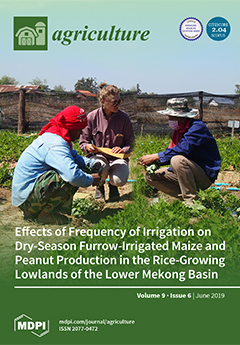This paper assesses the ability of fodder plants to reduce methane (CH
4) emissions while simultaneously improving animal productivity in Ethiopia. Enteric CH
4 emissions from ruminants in Ethiopia increased by 12% or ≈ 6197 Gg CO
2-eq. in 2017 compared to the year 2011. In this study, six tropical multipurpose forages (
Leucaena leucocephala (Lam.) de Wit,
Moringa stenopetala (Bak.f.) Cuf.,
Sesbania sesban (L.) Merr.,
Cajanus cajan (L.) Millsp.,
Crotalaria juncea L., and
Lablab purpureus L.(Sweet)) and maize stover were characterized in terms of chemical composition, in vitro CH
4 production, and CH
4 concentration (%). The objective was to identify forages with low CH
4 production potential but with adequate forage quality. The forages differed significantly in chemical composition and in enteric CH
4 emission. The dry matter (DM), ash, crude protein (CP), neutral detergent fibre (NDF), acid detergent fibre (ADF), and acid detergent lignin (ADL) ranged between 89.4–95.4%, 6.08–12.5%, 3.3–30.7%, 20.4–76.0%, 10.8–44.8, and 2.9–14.1%, respectively. All forage plants, except maize stover, contained high CP content above a threshold value (i.e., 7%).
Cajanus c. generates the lowest amount of CH
4 (32.83 mL/0.2 g DM incubated). CH
4 concentration (%) was used as a potential indicator to determine the capacity of a plant to lower CH
4 production. Among the studied species,
L. purpureus showed the highest CH
4 reduction potential (16%) followed by
C. juncea (23.45%),
M. stenopetala (24.2%), and
L. leucocephala (25.5%).
M. stenopetala was the most frequently preferred by the farmers followed by
C. juncea and
L. leucocephala. We concluded that
M. stenopetala,
C. juncea, and
L. leucocephala can be promoted as valuable feed resources for ruminants while simultaneously reducing CH
4 emissions.
Full article





